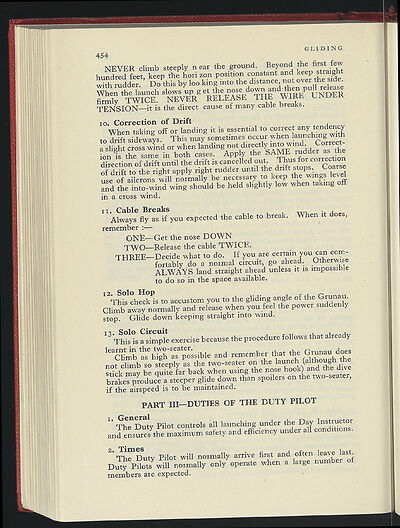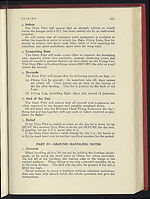1957-58
(472)
Download files
Complete book:
Individual page:
Thumbnail gallery: Grid view | List view

GLIDING
454
NEVER climb steeply near the ground. Beyond the first few
hundred feet, keep the hori zon position constant and keep straight
with rudder. Do this by loo king into the distance, not over the side.
When the launch slows up g et the nose down and then pull release
firmly TWICE. NEVER RELEASE THE WIRE UNDER
TENSION—it is the direct cause of many cable breaks.
Io.
Correction of Drift
When taking off or landing it is essential to correct any tendency
to drift sideways. This may sometimes occur when launching with
a slight cross wind or when landing not directly into wind. Correct-
ion is the same in both cases. Apply the SAME rudder as the
direction of drift until the drift is cancelled out. Thus for correction
of drift to the right apply right rudder until the drift stops. Coarse
use of ailerons will normally be necessary to keep the wings level
and the into-wind wing should be held slightly low when taking off
in a cross wind.
II.
Cable Breaks
Always fly as if you expected the cable to break. When it does,
remember :—
ONE—Get the nose DOWN
TWO—Release the cable TWICE.
THREE—Decide what to do. If you are certain you can com-
fortably do a normal circuit, go ahead. Otherwise
ALWAYS land straight ahead unless it is impossible
to do so in the space available.
I
12.
Solo Hop
This check is to accustom you to the gliding angle of the Grunau.
Climb away normally and release when you feel the power suddenly
stop. Glide down keeping straight into wind.
13.
Solo Circuit
This is a simple exercise because the procedure follows that already
learnt in the two-seater.
Climb as high as possible and remember that the Grunau does
not climb so steeply as the two-seater on the launch (although the
stick may be quite far back when using the nose hook) and the dive
brakes produce a steeper glide down than spoilers on the two-seater,
if the airspeed is to be maintained.
PART
III—
DUTIES OF THE DUTY PILOT
I.
General
The Duty Pilot controls all launching under the Day Instructor
and ensures the maximum safety and efficiency under all conditions.
2.
Times
The Duty Pilot will normally arrive first and often leave last.
Duty Pil
o
t
s
will normally only operate when a large number of
members aie expected.
454
NEVER climb steeply near the ground. Beyond the first few
hundred feet, keep the hori zon position constant and keep straight
with rudder. Do this by loo king into the distance, not over the side.
When the launch slows up g et the nose down and then pull release
firmly TWICE. NEVER RELEASE THE WIRE UNDER
TENSION—it is the direct cause of many cable breaks.
Io.
Correction of Drift
When taking off or landing it is essential to correct any tendency
to drift sideways. This may sometimes occur when launching with
a slight cross wind or when landing not directly into wind. Correct-
ion is the same in both cases. Apply the SAME rudder as the
direction of drift until the drift is cancelled out. Thus for correction
of drift to the right apply right rudder until the drift stops. Coarse
use of ailerons will normally be necessary to keep the wings level
and the into-wind wing should be held slightly low when taking off
in a cross wind.
II.
Cable Breaks
Always fly as if you expected the cable to break. When it does,
remember :—
ONE—Get the nose DOWN
TWO—Release the cable TWICE.
THREE—Decide what to do. If you are certain you can com-
fortably do a normal circuit, go ahead. Otherwise
ALWAYS land straight ahead unless it is impossible
to do so in the space available.
I
12.
Solo Hop
This check is to accustom you to the gliding angle of the Grunau.
Climb away normally and release when you feel the power suddenly
stop. Glide down keeping straight into wind.
13.
Solo Circuit
This is a simple exercise because the procedure follows that already
learnt in the two-seater.
Climb as high as possible and remember that the Grunau does
not climb so steeply as the two-seater on the launch (although the
stick may be quite far back when using the nose hook) and the dive
brakes produce a steeper glide down than spoilers on the two-seater,
if the airspeed is to be maintained.
PART
III—
DUTIES OF THE DUTY PILOT
I.
General
The Duty Pilot controls all launching under the Day Instructor
and ensures the maximum safety and efficiency under all conditions.
2.
Times
The Duty Pilot will normally arrive first and often leave last.
Duty Pil
o
t
s
will normally only operate when a large number of
members aie expected.
Set display mode to:
![]() Universal Viewer |
Universal Viewer | ![]() Mirador |
Large image | Transcription
Mirador |
Large image | Transcription
| Games and sports in the army > 1957-58 > (472) |
|---|
| Permanent URL | https://digital.nls.uk/248857133 |
|---|
| Description | 'Games and Sports in the Army' was an annual publication produced by the British War Office between the 1930s and 1960s. This included the Second World War. It outlines the rules and regulations for games and sports played by members of the armed forces. It features names and photographs of team members, and examples of contemporary advertising. |
|---|---|
| Shelfmark | GWB.52 |

